Hip Bursitis - An Overview
bursae = plural form of bursa
Hip bursitis is a very painful condition in which a bursa sac inside of the hip becomes irritated and inflamed, affecting the bursa and the soft tissue around it. A bursa is a sac of synovial fluid, rich in protein and collagen that acts as a cushion to protect soft tissue, such as tendons, ligaments and muscle, from friction and excess pressure.
If you are experiencing bursitis, then your bursa has become swollen with synovial fluid, blood and-or pus. If the bursa fills with blood, it is usually due to trauma - a specific injury such as a fall or perhaps even a car accident. If the bursa sac contains pus, this means it is infected (also known as septic) and you are advised to seek medical attention immediately as this can quickly become life threatening. In any case, once the bursa has swollen then the bursa can no longer serve its purpose as a friction reducer; you will most likely find that the swollen bursa sac can cause a lot of pain and interrupt your lifestyle quite substantially.
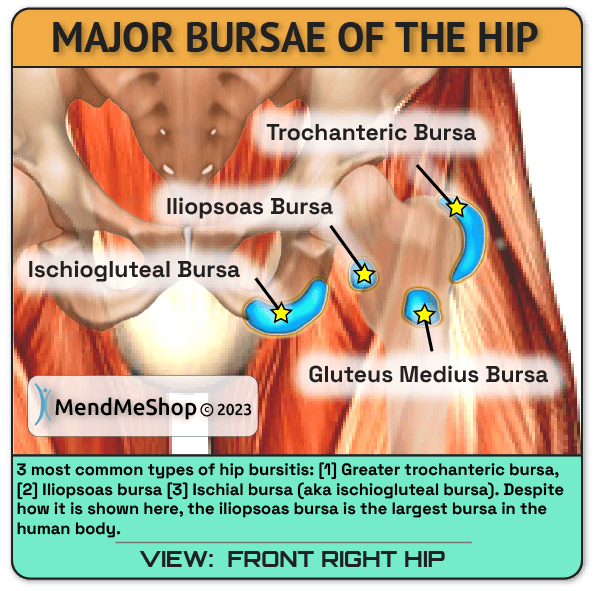
We have over 150 bursae in our bodies with most of them located in our joints. Bursae in the hip include the greater trochanteric bursa, deep trochanteric bursa, the iliopsoas bursa, gluteal medius bursa, ischiogluteal bursa, and ischial tuberosity bursa located in the back of the joint. The 3 most common types of hip bursitis occur in the greater trochanter bursa followed by the iliopsoas bursa and ischial bursa (also called the ischial bursa).
Bursae are most often injured from overuse or as a result from excessive strain (even a traumatic accident or fall). For the hip, perhaps imagine the strain a seat belt might put on your hips if you are in a car accident. Bursitis in general is most common in males (80%) between the age of 40 and 60; however bursitis that occurs due to trauma is most common before the age of 35. (source [1]). Hip bursitis specifically, is most common in adults over age 40. (source [2])
Poor posture, hip joint degeneration (arthritis, osteoarthritis), auto-immune disorders (gout, psoriasis, thyroid disease), previous surgical intervention, hip bone spurs / calcium deposits and and leg-length inequality (one leg is shorter than the other) are all common causes of hip bursitis (source [3]). Basically, any type of injury or condition that alters the way you walk, stand or sit can lead to a change in the position of the bones and tissue in your hip joint - and these changes in positioning can result in hip bursitis. Hip injuries, especially degenerative conditions like osteoarthritis or arthritis, can also be hereditary, you may notice more problems with your hip if you have older family members that have suffered from hip injuries in the past.
Everyone can be affected by degeneration of their hip over time. As we age, our tissue ages too. Any repetitive or frequent movement can place stress on the bursae in your hip over the years. This includes restricted movement due to sitting at a desk job for years, or even physical activities on the weekend. Know that this injury can happen to anyone and is not just isolated to athletes or the elderly.
In most cases, mild to moderate hip bursitis can be treated through conservative treatments outlined by a physician.
There are 2 different kinds of bursitis - "septic" and "aseptic" bursitis.
"Septic Bursitis" describes a bursa that is infected. Septic bursitis is not something to take lightly, as an infected bursa can spread infection throughout the body and become life-threatening. Consult your physician if you think you have septic bursitis as only they can confirm the condition and prescribe proper treatment options.
If the bursa is septic, getting to a doctor quickly may save your life!
"Aseptic bursitis" will happen when your bursa isn't infected but your bursitis has been caused by inflammation from another soft tissue injury. For hip bursitis this might mean that you've hurt some of the tissue around your hip from a trauma (like a fall) or from repetitive damage over time.
Common Types of Bursitis in the Hip
Trochanteric Bursitis
The trochanter bursa functions to prevent the iliotibial band (IT band) from rubbing against the greater trochanter of the femoral head. The IT band runs from the iliac crest (crest of the pelvis) down the side of the hip and leg, and inserts at the upper tibia (top of the knee.) It is mainly used along with the gluteus maximus for bracing the leg and knee when in the standing position. Trochanteric bursitis most often results from the iliotibial band (IT Band) tightening and rubbing against the bursa.
The IT band is made up of thick, fibrous tissue that is considered connective tissue similar to a tendon. When it becomes irritated or inflamed, it can irritate the trochanter bursa causing inflammation within the bursa. Therefore, sufferers of iliotibial band syndrome (ITBS) may experience trochanteric bursitis at the same time.
Trochanteric bursitis is often used as a general term to describe pain around the greater trochanteric region of the hip and is often confused with Greater Trochanter Pain Syndrome (GTPS). Trochanteric bursitis is ONE of many component that make up GTPS - the other notables relating to conditions that cause pain in the lateral side of the hip.
Learn more about trochanteric bursitis.
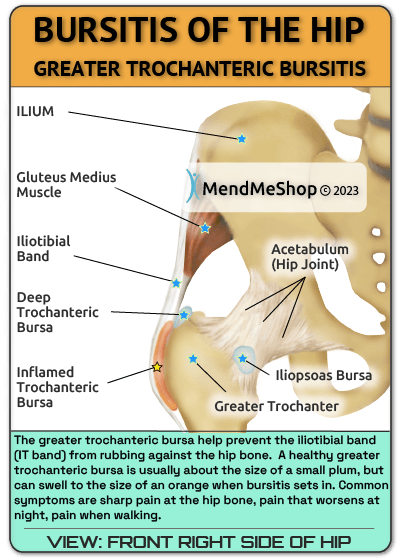
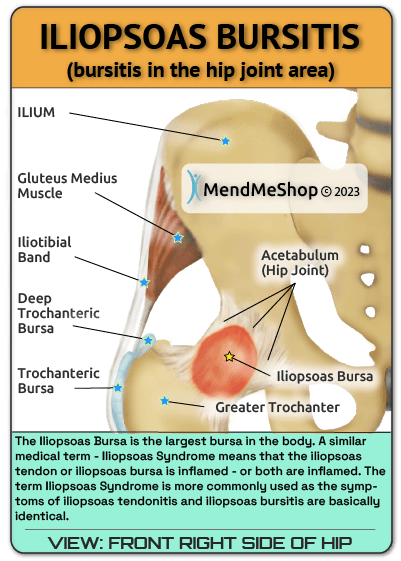
Iliopsoas Bursitis
The iliopsoas bursa lies between the front of the hip bone and the iliopsoas muscle, helping reduce friction between this bone and muscle. This bursa usually becomes inflamed due to overuse of the iliopsoas muscle. Overuse can tighten the muscle, causing more pressure on the bursa when the hip is flexed. Iliopsoas bursitis can be mistaken for tendinitis or hip arthritis because of the location of pain and other symptoms.
Learn more about iliopsoas bursitis.
Ischialgluteal Bursitis
The ischial bursa is located at the bottom of the ischium (lower hip bone). It cushions the gluteus maximus muscle from the ischium when sitting on hard surfaces or when sitting for long periods of time. Ischial bursitis may cause back pain and due to the location, it is often mistaken for sciatica pain.
General Information about Bursitis
There are two types of bursitis: chronic and acute. Chronic bursitis is caused by overuse or repetition of a certain area or joint. It will develop over time, and will likely get better and flare up over a long period of time. Acute bursitis is often the result of a trauma to the hip, such as a fall. It can also result from a simple movement such as lifting and twisting the wrong way or may come on quickly following irritation from hip post surgery.
Some suffers cannot recall what triggered the hip pain, which is why some will not seek treatment, hoping it will resolve itself. However, it is always wise to address and deal with hip pain as soon as possible so that the problem does not worsen.
Hip Bursitis Symptoms
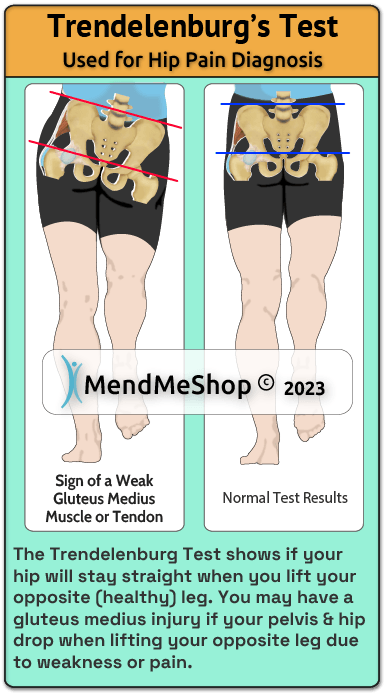
A healthy trochanter bursa is usually about the size of a small plum, but can swell to the size of an orange when bursitis sets in. This is what creates the soft tissue damage in the area. Other symptoms you may experience include:
- Pain around the bursa location that may extend down the groin and thigh
- Swelling, tenderness in the area of the bursa
- Pain my increase when the hip is flexed
- Difficulty sleeping due to pain
- Limping
- The area around the bursa is hot to the touch
- Stiffness and tightness in the hip joint, groin and possibly the knee due to a tight muscle (iliopsoas) or tendon (IT band)
The Painful Symptoms of Acute & Chronic Hip Bursitis
If you have hip bursitis, you will mainly feel pain and experience swelling right at the side of your hip. The side of your hip will feel tender at first and you may feel pain when you press on the outside of your hip. Pain can sometimes radiate down the outside of your thigh or into the buttocks.
The pain you'll feel for acute (short-term) vs. chronic (long-term) hip bursitis will be different. In the beginning you might feel a sharp, intense pain at your hip. The longer you have this injury the more this pain will spread out into more of an achy feeling. One clear sign that you've re-injured your hip while recovering from hip bursitis is feeling that sharp, intense pain again if you've overworked it.
If you feel more pain at night while lying on your injured hip or performing activities like walking, squatting / bending down and climbing stairs then you might have a moderate case of hip bursitis.
You may even notice an intense pain while getting up from a seated position - especially if you have a desk job, spend a lot of time seated on the couch or a kitchen chair during your "down time" or drive in your car for long distances.
Over time, if left untreated, you will start noticing more and more constant pain and have trouble sleeping at night. As I mentioned before, if this injury is left untreated you might need to get your bursa removed through surgery (a bursectomy). You might even suffer from "septic" bursitis - where your bursa gets infected by a bacteria. On-going pain, chronic swelling, or symptoms of an infection (fever or a general sick feeling) should be treated immediately by a doctor.
If you think that you're suffering from hip bursitis and your mobility is steadily declining, the first thing you need to do is see your doctor. Only your doctor can give you a proper diagnosis and from this, determine a course of proper treatment.
Hip Bursitis Causes
Bursitis of the Hip has been found to be statistically more prevalent in cases where the sufferer is involved in, or experiences one or more of the following factors:
- Running, or participation in sports that involve a lot of running

- Activities which require repeated hip flexion (i.e. ballet, hurdling, soccer)
- Bone spurs or calcium crystals that form inside can irritate the bursa
- Repetitive stress on the hip from running, jumping, or squatting
- An injury or blow to the hip
- Uneven leg length that causes excess pressure on the bursa
- Iliotibial band syndrome (ITB)
- Weak hip abductor muscles (gluteus medius, gluteus minimus and tensor fascia lata)
- Following surgery in the hip in which the bursa may have been irritated
Hip Bursitis Diagnosis
If you've been diagnosed with hip bursitis,
- Your doctor may decide to aspirate (drain fluid from) the bursa, surgically remove the bursa (known as a bursectomy) or recommend conservative treatment options. Usually conservative treatment methods are all that's needed to treat hip bursitis, surgery is only ever used if long-term conservative treatment methods don't work. Conservative treatment options for bursitis typically include rest, icing of the injury, elevation and anti-inflammatory medication (reference: 1, 2, 3).
- Second, if your doctor has decided that your injury can be treated with conservative treatment options, then you'll find that many of our customers have had great success treating themselves with our powerful conservative treatment products - the Back/Hip TShellz Wrap® and our Arnica Pain Relief Cream.
- Or, if surgical intervention is required, talk with your doctor about using these same products for post-surgery recovery as you will find them to be effective for reducing post-surgery inflammation, enhancing range of motion and reducing scar tissue growth. Only use the TShellz Wrap after surgery when your surgeon or physician approves (6 weeks after surgery minimum).
Avoid Re-Injury & Recurring Inflammation to the Hip
Recovery from hip bursitis can take a long time but proper healing is essential to regain strength and get you back to the activities you enjoy. Complete recovery can be easily delayed by re-injury to the tendons, ligaments or other soft tissue in your hip.

It's almost impossible to keep from re-injuring soft tissue in your hip - especially if you incur hip bursitis due to an overuse injury. If you don't take care to remove the underlying cause of your bursitis, you will always be at risk of re-injury. Sometimes though, it's just not possible to stop everything and rest the injury properly; if your job is the reason you are suffering from hip bursitis, you need to seriously evaluate whether you should change professions - at least temporarily. What ends up happening is we continually re-injure and strain connective tissue in the hip through our work and daily activities - continually setting back our recovery time.
Unless you seriously choose to rest your hip and follow a conservative recovery protocol, you will find that 100% recovery is nearly impossible. Eventually, if left untreated, you might have chronic inflammation of your bursa and/or surrounding soft tissue; treatment becomes even more problematic at this point (you might need surgery to remove your bursa).
If you have an inflamed bursa in your hip, it is important to heal quickly and completely.
Time is unkind when it comes to an immobilized joint - you lose strength in your hip but worse than that, you lose the range of motion from atrophy (your flexible tendons, muscles and ligaments slowly shrink / waste away, decreasing joint elasticity). The more time that goes by with your hip immobilized, the more likely you'll wind up with a chronic problem (long term injury such as tendonitis or chronic inflammation / bursitis pain). Basically it means that your hip won't perform as well as it once did and it becomes more prone to injury again later on; this is why it is important to heal quickly and completely. Minimizing the healing time of your hip bursitis should be an obvious goal, as hip bursitis will limit your ability to go about your daily routine. If your long-term (chronic) hip bursitis is left untreated, calcium deposits can form within the bursae; these calcium deposits can lead to permanent stiffness in your injured hip. (source [3])
Dealing with continuous re-injury, chronic inflammation / swelling and the possibility of getting calcium deposits increases your risk of winding up with a chronic hip condition or a serious case that needs to be resolved with surgery.
You need to avoid chronic inflammation and the potential for developing calcium deposits. If you don't, your hip bursitis injury may plague you forever. This is why it's so important to continuously use conservative treatment tools to heal any recurring soft tissue damage and swelling from your bursa before it can build into something big. If you suffer from hip bursitis, having the right tools to use on a daily basis makes all the difference for a quick recovery.
Conservative Home Treatments for Hip Bursitis
Relieving the symptoms of bursitis initially focuses on keeping the pressure off the bursa. Surgery may be required if your bursa irritation is a result of a bone formation problem, such as a bone spur. If your bursitis is caused by an infection (septic bursitis), the doctor will probably drain the bursa sac with a needle and prescribe antibiotics to treat the infection. For non-infectious bursitis, the preliminary treatment starts with non-operative options such as cold compression via use of a Cold Compress or Ice Pack.
The most important factor in healing bursitis is resting your hip. This can be difficult when you have to carry on with daily activities, but resting whenever you can is recommended. During your recovery you will probably have to modify or avoid the activities that stress your bursa until your pain and inflammation settle.
Treatments should involve decreasing swelling, relieving stress on the hip joint, correcting any bio-mechanical dysfunction (uneven leg length, bone spur, etc.), treating scar tissue, and then finally restoring strength and movement in your leg and hip. Circulatory Boost is recommended once inflammation has been calmed to heal the bursa and surrounding tissue faster and reduce the risk of bursitis returning.
It's generally understood by doctors and surgeons that hip surgery will introduce more scar tissue within muscles, fascia, tendons and ligaments (connective tissue) in your hip. This added scar tissue will be problematic, requiring PT and conservative treatment options post-surgery. When it comes to bursitis there's only a few surgical options for treatment - removal of the bursa sac (known as a bursectomy) from the bone; in time, the bursa will likely regrow. Scar tissue is a major reason why surgery is only performed as a last resort for chronic bursitis that has not responded to 2 to 4 months of conservative treatment methods.
Conservative treatment methods recommended include:
- Rest - This is important for initial recovery; rest and elevation will help reduce pain, swelling and inflammation in the early stages of injury. This can be difficult when you have to carry on with daily activities, but resting and elevating your hip whenever you can is recommended. During your recovery you will probably have to modify or avoid the activities that put stress on your hip until your pain and inflammation settle. However, too much rest can also be harmful, as hip immobility can cause stiffening in the joints. This is why rest should be used when reducing initial pain and swelling, but should not be considered for more long-term conservative treatment.
- Avoid Activities that Caused Your Hip Bursitis - While resting your hip it's also important to avoid all activities that may have caused your hip damage (especially any strenuous or repetitive movement). Continuing on with these activities will likely increase the severity of your injury, turning a mild to moderate case of tissue damage into a downward spiral of increasing damage that may severely impact your life later on. Also, trying to 'work around' your injury will eventually give rise to over-compensation injuries in other areas of your body (ie achilles, hip & knee pain due to your limping gait).
- Use a Cold Compress or Ice Pack - Cold is very effective at reducing pain and inflammation - use at the onset of the injury and during flareups. Immediate pain relief and reduced inflammation can also relieve some of the pressure that's being placed on your bursa although cold temporarily shortens connective tissue (tendons, muscle, fascia) causing more friction on the bursa sac. Generally, use cold when there is swelling but stop once swelling is down. In cases of chronic (long term) bursitis, there is typically little to no inflammation.
- Use a Back/Hip TShellz® Circulatory Boost Wrap - Once swelling has been reduced, you can use your own blood flow to maximize your rehabilitation. Knowing the body uses blood flow to heal soft tissue, this wrap is intended to introduce heat and an increase in blood flow to the application area; this in turn, will assist the body in its own repair process, helping decrease recovery time while reducing re-injury risk. Promoting blood flow and heat to the area will help to minimize the growth of scar tissue, increase tissue flexibility and help reduce onset of atrophy. This is why we recommend a TShellz Wrap treatment before undergoing activity - an increase in flexibility should help reduce risk of further injury while also assisting in the battle against atrophy (what we are saying is that you want to keep your joint flexible so pressure on the bursa is minimized and secondary injury risk will be reduced).
- For reducing discomfort while resting, (or to get some sleep) consider a High Quality Back Pillow and/or Knee Pillow for comfort while sleeping or sitting
- Rehabilitative Stretching under supervision of a PT or doctor. The intent of this is to provide you with increased range of motion, pain relief and strengthening of the surrounding tissue of the hip. Doctors or surgeons typically won't perform a surgery until they feel that their patient has put effort into treating the injury with conservative treatment methods. This may include up to 4 to 6 months of visits to a PT clinic. If you haven't experienced any improvement in your condition during that time then surgery may be considered.
- Stretching - Stretching your hip in PT and at home will help you to regain your range of motion much faster than not stretching at all. Stretching in many ways is key maintaining good Range of Motion (ROM) in the hip, and stretching can be made much easier with use of a TShellz Wrap® before to warm up soft tissue, and a Cold Compress or Ice Pack treatment after to prevent any return of swelling and inflammation.
General Guidelines for Dealing with Bursitis in the Hip
As mentioned earlier, it is important to treat bursitis in the early stages to reduce the symptoms, minimize damage and maintain a normal walking pattern. Resting your hip and reducing any activities that add pressure on your bursa will help to reduce pain and bursitis inflammation. By treating your bursitis in the early stages with conservative treatment methods, you are more likely to prevent long-term damage and chronic conditions from setting in.
Surgery to remove the inflamed bursa is normally not required for bursitis, however if you fail to see improvement with the conservative treatments, your physician may recommend surgery to remove the bursa completely. This removes the problem of an inflamed bursa, though it will leave you temporarily with less lubrication in your hip until the bursa grows back.
An important factor in healing bursitis is rest; during your recovery you should avoid activities that stress your bursa until pain and inflammation settle.
Treatments should involve decreasing swelling, relieving pain and stress on the hip, treating scar tissue, and then restoring movement. If you are performing an activity that could cause further trauma to the bursa, it is recommended that you protect the area to prevent further irritation or damage.
Regardless of the condition affecting your hip, you will find that conservative treatments your doctor provides are the best choice for a healthy recovery. Building strong healthy tissue allows you to regain strength and full range of motion with your walking.
The Back/Hip TShellz Wrap is a home treatment medical device that has pleasantly surprised many of our customers. Even with chronic cases such as arthritis - these products cannot cure arthritis, but they sure can bring down the swelling (and pain) when it flares up. Maintaining elasticity in the joint is a major concern for arthritis sufferers, and the TShellz Wrap will help fight atrophy (shrinking of soft tissue due to lack of movement) and strains as it is known to increase elasticity of soft tissue during and for some time after treatments. This is why we recommend TShellz Wrap® treatments before engaging an activity that may stress the injured area (ie. stretching, sports, etc). You simply won't find another product on the market that has the comfort, ease of use, and effectiveness of a TShellz Wrap.
Home Treatment Stage 1: Reduce Pain & Swelling with a Cold Compress or Ice Pack
The 1st step for conservative treatment of your hip bursitis when treating conservatively or even after surgery is to rest and reduce swelling to "open up" the area for more blood flow. Anyone in the health-care business knows that your blood supplies the oxygen and much needed nutrients required for your body to heal naturally from damage (including after surgery). This is why doctors and surgeons recommend cold compression within the first 72 hours of any tissue injury or following surgery.
Cold compression is recommended to reduce pain, swelling and tissue damage. Many doctors, surgeons and physical therapists consider cold compression to be the gold standard for treatment of inflammation and pain. On-going cold compression treatments can reduce, or even eliminate, the need for NSAIDs or other medications that can be harmful to your body.
Cold compression is known and trusted by most medical professionals. This is why for years doctors, trainers and other medical professionals have recommended RICE (Rest, Ice, Compression, Elevation) to treat the pain and swelling of fresh injuries, chronic pain, after any re-injury, and especially after surgery.
When to use a Cold Compress or Ice Pack:
- 24 to 72 hours after your initial injury or when you first notice pain and swelling to stop further damage to tissue, relieve pain, and decrease swelling.
- After exercise, workouts or activity of any kind to prevent re-injury.
- Before and after surgery during rehabilitation to control pain and swelling for both pre-surgery and post-surgery.
- Anytime you feel that soft tissue (muscles in particular) has been over-extended, over-worked, twisted, strained or sprained causing pain and swelling.
- Anytime you have swelling, sharp throbbing pain or inflammation.
- Any other situation where you need to draw the pain and inflammation out of the area.
Home Treatment Stage 2: Start TShellz Wrap® Treatments Once Swelling is Down
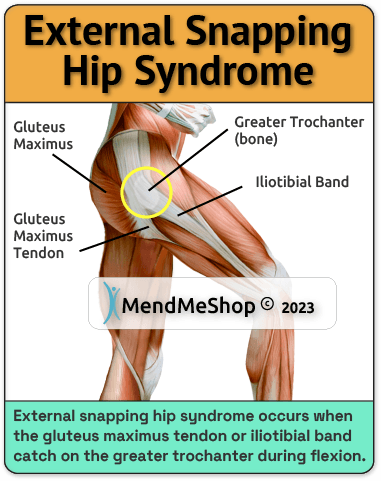
Once the inflammation in the hip has been reduced via a Cold Compress or Ice Pack it is time to take the next step in your treatment. Use a Hip TShellz Wrap® to improve blood flow while simultaneously helping surrounding soft tissue to become elongated and more elastic. What this means is that not only is increased blood flow helping the bursae and surrounding soft tissue to heal, the tendons/muscles/ligaments are now longer and more elastic due to the heat effect of the treatment. This, in turn, reduces pressure and friction on the bursae while simultaneously reducing the risk of atrophy (weakening of the muscles and tendons) in and around the hip. The TShellz Wrap® is a perfect tool to use at home to augment your massage and PT sessions, reduce the risk of re-injury and help keep your blood moving. Believe it or not, the best time for you to focus on avoiding re-injury and strengthening the weakened tissue is when the swelling's gone and your tissue has started to heal. It's vital that you don't go back to activities too soon because you might bring on a major setback in your recovery...
Improved blood flow helps reduce the risk of atrophy in muscles, tendons and ligaments. When you stop moving/using your hips due to pain, your muscles and other tissue can become weaker and dead tissue and toxins in the area can cause further tissue deterioration - this can lead to atrophy in the area and increase the risk of contracting more issues such as quadricep tendonitis, calf strain or achilles tendonitis. Furthermore, hip pain will increase the risk of overcompensation pain - basically the result of increased use of the feet, ankles and knees due to the change in gait (the way you walk). We have TShellz Wraps® for every major joint of the body, so if your ankles or knees are causing trouble, we can help there too!
By clearing the area of toxins and increasing the amount of oxygen and nutrients to the soft tissue in your hip, the risk of atrophy (muscle weakness and/or deterioration) is greatly reduced. Keeping your hip as healthy as possible throughout the healing process will allow you to improve strength again once your pain has gone and your bursitis has healed.
Promoting blood flow around injured tissue to help the body heal itself is a concept that's been used for centuries. Oxygen and nutrients, carried in your own blood, are critical for the body to heal itself. Without proper blood flow, your recovery rate from a soft tissue injury will be minimal, easily turning a 6 week recovery into long term deteriorating chronic nightmare due to re-injury, scar tissue and atrophy.
Who Should Use the TShellz Wrap®
We recommend the use of a TShellz Wrap®:
- If you have injured tendons, ligaments or muscle, then the TShellz Wrap® will provide the all-important function of boosting blood circulation where it is needed most.
- If you are dealing with soft tissue conditions affecting your range of motion.
- If you have a chronic soft tissue condition that has lasted for years- this device is intended to kick start the recovery process and help strengthen surrounding and supporting tissues.
- If you are still working with a soft tissue injury, the TShellz Wrap® will help relax injured soft tissue prior to work and after a day at the job.
- If you are still trying to enjoy your favorite activities such as gardening, tennis, golf, etc - use the TShellz Wrap® prior to activity to help reduce chances of re-injuring or re-aggravating those targeted tissues.
- If you are suffering from bursitis and want to treat a major source of it (inflammation and damage to tissue surrounding the bursa sac). Through trauma, overuse or degenerative changes, muscle and tendons surrounding the bursa sacs will tighten and constrict. When they do, they place pressure on the bursa, causing it to become irritated. Applying a TShellz Wrap® to the area will help relax tissue in the treatment area, taking pressure off the bursa.
- If you have been to a clinic for some form of massage or stretching and your PT or physician has recommended stretching and/or conservative treatments for home.
- If you have upcoming surgery scheduled for your soft tissue injury, then you will find a blood circulation booster to be a powerful tool after surgery to help surgically repaired tissues recover for long-term health. (once the surgery wound has healed and your physician has given the ok - minimum 6 weeks after surgery)
- If you are experiencing atrophy in your joint and want to reduce the risk of re-injury (or further injury) while stretching - we recommend its use every time before you stretch.
Increased Blood Circulation = Increased Healing Capability
TShellz Wraps® contain a unique Carbon Fiber Energy Pad which is flexible and will shape to conform to your body. This Energy Pad emits a uniform wave of perfectly safe energy over its entire surface. This energy is absorbed by soft tissue in the treatment area, opening blood vessels, resulting in an increase in blood flow. Increased blood circulation is what your body needs to maximize its cabability of healing soft tissue and this is why we recommend the TShellz Wrap®.
The Back/Hip TShellz Wrap® is an FDA Registered Medical Device and is suitable for use in therapeutic clinics and FROM HOME. It is completely safe for people and patients to use for themselves.
The technology found in a TShellz Wrap® has been used for decades in the worlds of professional and amateur sports - a contributing factor as to why athletes seem to recover from injuries so quickly.
Have you ever wondered by an athlete can return to activity after 4 or 5 weeks following a hip injury - while your average person takes much longer to return back to normal? The secret isn't really that much of a secret - it involves consistent treatments (meaning multiple times a day) using a treatment like the TShellz Wrap® to stimulate blood flow to the injured tissues. Most athletes have the luxury of using in-house facilities many times per day.
How many us can afford the time and money to visit a clinic multiple times a day? Very few indeed. This is how you can gain some of the advantages that athletes enjoy in their injury recovery - by using a device like the Back/Hip TShellz Wrap® two or three times a day on a consistent basis.
Consistent Treatments = Consistent And Long Term Improvement
What Else Makes the Back/Hip TShellz Wrap® So Special?
We believe the TShellz Wrap® to be one of the most effective home treatments to increase localized blood flow to soft tissue in and around the treatment area.
We can promise that you will receive a product that is designed to be safe and does what it is supposed to do... reduce pain (as stated in "Therapeutic Heat and Cold", 4th edition. - Ed. Justus F. Lehmann, M.D., Williams, and Wilkin) temporarily increase length & flexibility of soft tissue (as stated in "Therapeutic Heat and Cold", 4th edition. - Ed. Justus F. Lehmann, M.D., Williams, and Wilkin) and aid your body in recovering from tendon, muscle and other soft tissue injuries via enhanced blood flow.
The unit plugs into a standard wall outlet to get its power. The nice thing about the power supply is that the same unit can be used in North America and overseas as well. It has the capability to operate between 110v and 230v.
The TShellz Wrap® has a special signal controller that can be set for 3 different power levels of application (3=High, 2=Medium, 1=Low). The cord is long enough that you can sit or lie comfortably and watch TV, read or surf the net while you're using it.
Treatments are max 30 minutes in duration and the device can be worn over clothing. This allows you to use the device at work, at home, or really anywhere you have access to an electrical outlet.
When Should I Use My TShellz Wrap During the Day?
The most common question we receive from individuals prior to purchasing is - how many times a day should I be using my TShellz Wraps® and when should I be using them? While treatment plans will differ for each individual and their specific injury, there are general guidelines that should be adhered to.
- Use a Cold Compress or Ice Pack when you are experiencing inflammation (usually after exertion or movement of the injury area).
The TShellz Wrap® would then be used:
- Right after rising from bed in the morning (as this is when your joint is most stiff)
- Prior to going to bed at night (to relax the joint, allowing for better sleep)
- Before you know you will be using your injured joint (going to work, driving, walking/running, etc).
We Guarantee That If You Use Our Products on Your Bursitis for 60 days as Directed, Your Bursitis Pain Will be Greatly Reduced or Eliminated and Your Joint Flexibility will Increase. If This Does Not Happen, We Will Refund Your Money.
We are an FDA Registered Company, and our TShellz Wrap is an FDA Registered Medical Device suitable for use in hospitals and therapeutic clinics. Since it is deemed safe for patients to use themselves, the TShellz Wrap can be used for home treatment.
Home Treatment Stage 3: In Between Treatments With A TShellz Wrap®, Apply Our New Fast Acting Pain Relief Cream Called ARNICA INFUSION
Dealing with aches and pains affecting the foot, ankle, leg, knee, hamstring, hip, back, arm, shoulder, elbow, wrist, or hand? If so, then applying the Arnica Infusion to any of these targeted areas will bring about fast relief from the pain and sore tissues. Simply apply a small amount of cream to the body and moments later, you will experience a soothing and comforting sensation over the area.
Arnica Infusion is specially designed to relieve pain due to sore muscles and joints associated with arthritis, backaches, sprains, strains, and bruises. No matter if you are dealing with an acute injury, chronic pain, or a general "flare-up" - you will experience fast relief from pain and inflammation.
A lot of our customers asked us for pain cream, so we focused our resources and came up with what we believe to be the most effective, fast acting, topical pain relief cream you can buy without a prescription.
You are likely familiar with some of the standard topical creams on the market as most of our customers use them. They are mass marketed and even found in most department stores... Well, we are here to say that Arnica Infusion goes many steps beyond what they offer.
Made in the USA at an FDA registered manufacturing facility, you can be assured that Arnica Infusion is both safe and effective. We only source top grade ingredients while implementing strict quality control checks during every step of the production process. Expect the same high quality that MendMeShop customers have been accustomed to since we started the company in 2005.
The "Cool Blue" formula is the perfect balance between the smooth application of a cream and the effective absorbing factor of a gel. It is not too thick and not too thin - just the right texture. Best of all, it feels very nice on the skin!
Each application of Arnica Infusion feels so comforting and soothing, we are certain it will become an item you will not want to live without.
Arnica Infusion Ingredients
The Arnica Infusion formula is based on a combination of scientific research and the use of high quality ingredients. The properties within the formula were chosen for their pain relief, anti-inflammatory, and soothing qualities.
The acting ingredients within the formula include ones many of us are familiar with; along with ones that have not received a lot of publicity (only in research circles). Extensive testing resulted in a blending of ingredients that provides the most synergistic of benefits.
The notable ingredients in the Arnica Infusion formula include:
- Arnica - powerful anti-inflammatory, speeds recovery, enhances circulation
- Menthol - provides deep penetrating pain relief with a nice cooling sensation
- Vitamin B6 - promotes normal nerve function
- MSM - supports healthy connective tissues, anti-inflammatory
- Ilex Leaf Extract - increases circulation, skin conditioner
- Vitamin E - anti-inflammatory, enhances circulation, hydrates the skin
- Aloe - anti-inflammatory properties, soothes the skin
- Tea Tree - enhances penetration of ingredients
Extensive quality control procedures during the manufacturing process ensure the ingredients and final product are both safe and effective. We would not stake our reputation on anything but the best.
When Do I Apply the Arnica Infusion?
While At Work
Apply Arnica Infusion at work to help reduce acute discomfort associated with overuse of muscles and joints. No matter if you are in a physical demanding job or work within an office environment, you will be placing stress on different parts of the body and aches and pains will result.
Before Or After Work, Sports, & Activity
If you suffer from a sprained ligament, pulled muscle, strained tendon, or even bruising - apply Arnica Infusion for quick relief from the pain.
If You Are In Chronic Pain & Need To Get Some Sleep
If you have experienced this level of pain, then I don't really need to explain it. Application of Arnica Infusion can be done up to a maximum of 4 times per day on a consistent basis to help bring about substantial yet temporary relief from pains.
In-between Treatments, Limber Up With The TShellz Wrap®
Follow up your TShellz treatments with an application of Arnica Infusion. Combine the pain relieving benefits of Arnica Infusion along with the therapeutic benefits of the wraps to make your recovery go much more smoothly.
Do not apply Arnica Infusion within a 2 hour timespan before a TShellz Wrap® treatment.
Whether you decide to use the Arnica Infusion 1) on its own or, 2) in conjunction with the TShellz Wrap® and other treatments - you will not be disappointed with the results. We guarantee it!
Keep using the TShellz Wrap® before activity and when you notice any stiffness in your hip to 'warm up' your muscles, tendons & ligaments.
Anti-Inflammatory Medications for Bursitis
NSAIDs, non-steroidal anti-inflammatory drugs, can be used if required to help manage your pain. However, these aren't recommended for long term use, as they can cause gastrointestinal difficulties and increase the risk of cardiovascular disease. The TShellz Wrap®, when used in conjunction with NSAIDs can greatly improve the effect of the medication; this can not only help you heal quickly but also reduce the amount of NSAIDs that you ultimately may require.
Surgical Procedures for Bursitis
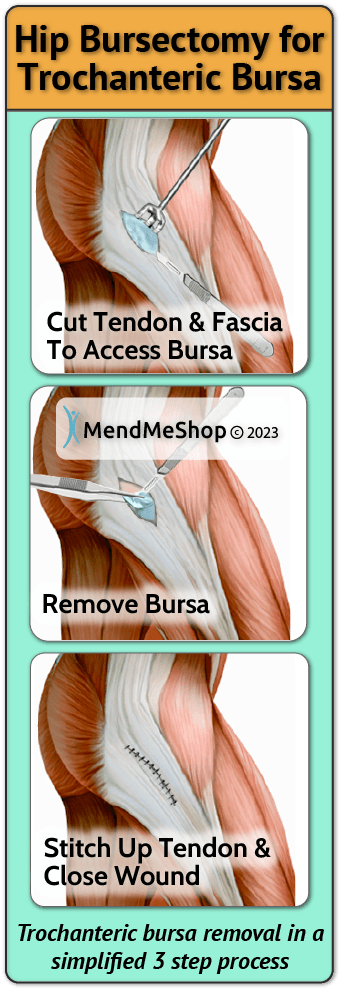
Your doctor may aspirate your inflamed bursa. This involves removing the extra fluid that has built up with a needle. Sometimes, the fluid will be tested at a laboratory to rule out infection.
If your bursitis does not get better with conservative treatments, the bursa may be surgically removed. Usually this is done by hip arthroscopy, which is a surgical procedure where tiny incisions are made and a pencil-sized camera is inserted into the hip. A small shaver is inserted into another incision, and is used to remove the swollen bursa altogether. The surgeon will then look for any damage to the hip and make repairs if necessary. This is also done to remove any bone spurs.
Recovery time from a surgery will depend on a number of different factors including your healing ability, diet, rest and how many procedures were done in your surgery.
Post-op recovery time can be reduced with the use of Cold Compress or Ice Pack and a TShellz Wrap® following surgery. Cold compression is recommended by doctors after surgery to treat your pain in a natural, non-addictive way and to reduce swelling. Once the incision has healed, speak with your doctor about the use of a TShellz Wrap®. The TShellz Wrap® encourages more oxygen and nutrients to flow to the area to speed healing and improve the strength of the soft tissue in your hip. Using the TShellz Wrap® as soon as you can following your surgery will help prevent and minimize the scar tissue that forms as you heal. Treating scar tissue is the most important step following surgery, especially in a joint, to improve the range of motion in your hip. Leaving the scar tissue untreated can lead to stiffness, chronic hip pain, osteoarthritis or other chronic conditions.
Read more about Bursitis Surgery here.
Rehabilitation Exercise for Bursitis
PT is a beneficial way to restore atrophied muscles and improve strength and mobility after treating bursitis. The type of PT and the duration will be dependent on the tissue damage and your symptoms. When you are treating or recovering from bursitis, it is important to ensure you do not perform any exercises that will further irritate the bursa.
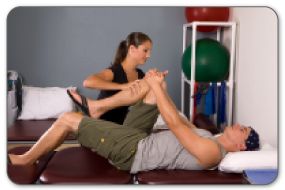
Once your pain starts to diminish, a physiotherapist will set up an individualized strengthening and stretching exercise program for you to perform at home or in the gym. This will be based on your needs and abilities, and will help you return to performing your normal routines.
Individuals will often lift weights on their own, to try and build up their strength. However, in doing so, they can do more damage to their joint. It is extremely important to strengthen your muscles properly, as they may have weakened during the period of non-use. A trained therapist will help to ensure your rehabilitation process is appropriate and effective. For best, long term results use TShellz Wraps® at home, in conjunction with PT and an exercise program.
Key Points To Keep in Mind When Treating Bursitis, Tendonitis & Other Connective Tissue Injuries In The Hip
1: Make Sure That Complete Healing is Your #1 Goal
We all know that if the injury was healed, the pain would go away but what about the opposite situation? If the pain is gone, does that mean the injury is better? Unfortunately, this is not always true.
Too many people only focus on suppressing pain symptoms while providing less attention to the true healing aspects of the body. Experiencing less pain, while obviously a good short-term goal, never equates to underlying healing. Scar tissue can remain for months after one gets to a point of being relatively pain-free. However, as long the weak and brittle scar tissue remains, you are susceptible to re-injury or re-aggravation. Certain motions or movements can cause the weaker tissue to easily tear - resulting in some reversal of the recovery up until that point.
This is why we recommend for people to continue with their doctor or therapist recommended exercises and to continue with mild treatments of the TShellz Wrap® for a period of time - to better ensure complete healing.
Ongoing treatments to enhance circulation will soothe, relax and help promote a healthy recovery of your damaged hip muscles and tendons. Back/Hip T•Shellz treatments will also allow your soft tissue to extend further due to the deep warming sensation created by the enhanced circulation to the treatment area. The more extensible your tissues are, the less likely they are to strain or sprain.
Soft tissue injuries are a race against time. The faster and stronger you heal tissue in your hip, the less chance there is for re-injury or other problems (such as overcompensation injuries) later on.
2: Resting Your Hip Will Help, But Only Temporarily
People tell us all the time, "I was told that if I stay off my feet for a few weeks, my hip pain will disappear for good." The truth is, it is easy to let knee pain keep you in bed or on the couch for a very long time. The problem is, if you keep your knee(s) inactive, atrophy will quickly compound the issue. As the muscles, tendons and ligaments in your knees and lower legs shorten and weaken, you will quickly find that your knee will feel unstable when you do use it; you will be much more likely to strain your knee or pull a calf muscle and your knee range of motion will be greatly reduced.
It may take weeks or months for atrophy issues to surface, but when they do, merely resting will not solve the underlying issues. You need to utilize options that will combat atrophy, treat the source of pain and keep soft tissue flexible and healthy as possible.
Resting has a role to play, but it is only one small factor in a recovery plan.
3: Identify What is Causing Your Hip Problem & Fix It. Otherwise, It May Come Back
In order to get lasting relief, you need to identify all the factors that are contributing to your hip pain. An example of some factors that may or may not be relevant are:
- muscle imbalances
- pinched nerve(s) in the knee, ankle, hip or lower back (ie. sciatica)
- short leg syndrome
- obesity
- flat footedness
- hip arthritis
- trauma
- chronic knee problem(s)
A huge number of people who contact us are unsure about the true causes of their discomfort. It really goes to show how important it is to get a proper diagnosis from your physician and get to the root cause. To really deal with a injury, you have to know the injury is - so get to the doctor and find out.
4: Know that Hip Pain isn't the Only Proof You're Still Injured

Would you know you injured yourself if there was no pain? Probably not! Pain and swelling perform a useful role in letting you know that you did, in fact, injure yourself. Pain and swelling are what get you to seek out medical attention in the hopes of finding a way to reduce the pain and heal your injury.
Hip bursitis is capable of causing extreme pain. Modern medicine is often quite successful at pain suppression and this is truly a great gift - however, too many people only focus on suppressing pain symptoms while providing less attention to what is occurring in their hip joint. Be careful with pain-killers that mask the pain as overuse can give you a false sense that your injury is gone. Strive to reduce the inflammation and maintain or even improve flexibility in the hip while avoiding re-injury to see a reduction in pain.
On-going TShellz Wrap® treatments at home, every day, are intended soothe, relax and promote blood flow to connnective tissue. Consistent TShellz® Circulatory Boost Wrap treatments before activity or work will help warm up the area, increasing soft tissue elasticity & flexibility; this in turn will also reduce the risk of re-injury.
The Fight Against Atrophy
Shortened muscles and tendons due to lack of use is a real problem during recovery. When you start to feel better and use the joint, the shortened muscles and tendons get over-strained, introducing small microtears. These microtears start the formation of scar tissue, which unlike muscle or tendon, is completely inflexible. Once there is scar tissue in there, the tears will continue; eventually you've got a serious problem with a joint that does not flex as much as it did before and this becomes a chronic condition. You'll know you have scar tissue when you get shooting pain if you stretch your joint too far... it is something that physical therapist's often deal with (ie. shoulder manipulation).
To prevent this, use the TShellz Wrap before undertaking any significant activity, as this type of treatment is known to increase flexibility and length of tissues in the area of application. This is actually why we advise tendonitis sufferers to treat themselves with a TShellz Wrap first thing in the morning before activity (activity stresses muscles & tendons). After treatment, tissue in the area will be more flexible - this means it will be able to handle higher stresses before it starts to micro-tear. The ability for soft tissue to stretch further before micro-tearing will allow you to gently stretch your recovering joint without re-injuring it yet again. This is a huge boon for recovery. We also highly advise the TShellz Wrap it for post surgery recovery, as surgery will always introduce scar tissue and TShellz Wrap treatments in post-op recovery will reduce scar tissue growth, increase joint flexibility and get you back on your feet faster.

MendMeShop Arnica Infusion Pain Relief Cream
Pain Keeping You Awake?
Pain Keeping You In Bed?
Pain Got You On Edge?
Temporary Relief from Serious Pain For People Who Are Serious About It!

MendMeShop Hip/Back TShellz Wrap®
This wrap is designed to:
- increase extensibility & flexibility of muscles in the back during treatment & for a short while after
- increase blood flow in the application area
- be used on the upper back, lower back, hips, chest & abdomen
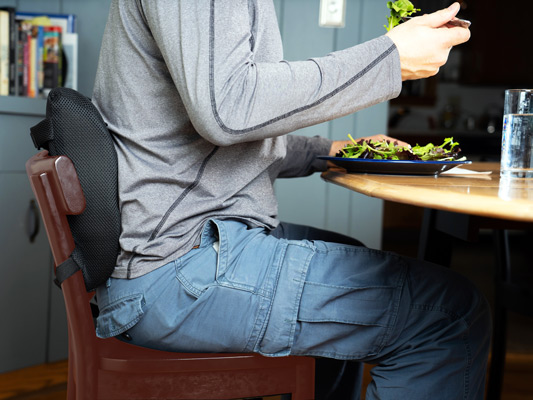
MendMeShop's Back Pillow / Lumbar Support
This is by far the best knee pillow we have ever tried
- Perfect Size & Shape
- Not too Soft or Hard
- Removable, Washable Cover
- Multiple uses: I use it often between neck and shoulder when reading in bed.
...A Quick Recap of Benefits That Can Be Achieved Via the TShellz Wrap®..
- We have TShellz Wraps® that can fit on the back, hip, leg, arm, shoulder, knee, foot, toes, wrist and ankle
- It can be used before exercise to warm up the problematic joint to reduce the risk of injury (heat elongates soft tissue and makes it more flexible)
- FDA Registered medical device for use in home or clinics - high quality, 1 year warranty, 60 day trial period (100% refund guaranteed)
- Increases temporary flexibility and length of tissues (reducing the re-injury factor)
- It soothes pain and whisks away toxins
- Carbon fiber Energy Pad is strong, lightweight, and flexible - contours very easily
- A boost in blood flow helps maximize the body's ability to recover from soft tissue damage. This can be beneficial in saving time and money when associated with doctor or physical therapist visits
- A boost in blood flow will maximize the body's ability to recover quickly. This can be beneficial in post-surgery rehabilitation, getting you back to work faster. Do not use until at least 6 weeks after surgery, and only after approval from your doctor.
AidMyBursa advisors do not work on commission, so be assured you will only receive fair and objective information.
Product specialists are available 9:00 am to 5:00 pm Eastern Standard Time Monday to Friday.
If any question or concern arises, call us or simply send us an email at any time (we check our emails constantly all throughout the day and night.. even on holidays!). We will respond as soon as possible.
North America Toll Free 1-866-237-9608
Outside North America +1-705-532-1671
FREE SHIPPING ON ALL PRODUCTS CURRENTLY ENABLED
Please be aware that this information is neither intended nor implied to be a substitute for professional medical advice. All testimonials and comments reflect the real life experiences of individuals that used our products, however, individual results may vary. Always seek the advice of your physician or other qualified health provider before using any of our outstanding products to make sure they are right for you and your condition or if you have any questions regarding a medical condition.
For more information, call us via: 1-866-237-9608 or send us an email. View our Privacy Policy.
The terms Inferno Wrap®, Freezie Wrap®, T-Shellz® and Mendmeshop.com® are registered trademarks of In.Genu Design Group Inc.
All images shown are exclusive Copyright© 2006 - 2025 AidMyBursa.com.
Sources:
1. (2020) Bursitis - an overview | ScienceDirect Topics. Retrieved May 24, 2023, from https://www.sciencedirect.com/topics/immunology-and-microbiology/bursitis
2. (2018) https://www.webmd.com/pain-management/arthritis-bursitis
3. William C. Shiel Jr., MD, FACP, FACR. (2023) Calcific Bursitis Causes, Symptoms, Treatment, Medications, Prevention. Retrieved May 24, 2023, from https://www.medicinenet.com/calcific_bursitis/article.htm